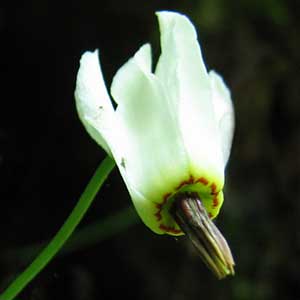Dodecatheon dentatum
Dodecatheon frigidum
dentate shooting star, tooth American cowslip, white shooting star
western arctic shootingstar
not obvious at anthesis, or sometimes erect to slightly horizontal, slender;
roots white or reddish;
bulblets absent.
obvious at anthesis, often horizontal and elongated, slender to stout, (often woody);
roots reddish;
bulblets absent.
(3.5–)8–20(–30) × (1–)2.5–6(–7) cm;
petiole slightly winged;
blade ovate, base decurrent onto stem, abruptly tapering to petiole, margins subentire to sinuate or crenate, surfaces glabrous.
(2–)3.5–12(–19) × 0.7–2.5(–4.5) cm;
petiole slightly winged or slender (at least basally);
blade ovate to oval, rarely oblong to spatulate, base slightly to obviously decurrent onto stem, abruptly tapering to petiole, margins subentire to crenate-dentate, surfaces minutely glandular-puberulent or glabrous.
(1–)2–5(–11)-flowered;
bracts lanceolate, 1.5–5(–8) mm, glabrous.
2–7-flowered;
bracts narrowly lanceolate, 3–8 mm, glandular-puberulent.
0.8–5 cm, glabrous.
0.5–2.5(–3) cm, glandular-puberulent.
calyx light green, 4–6 mm, glabrous, tube 2–3.5 mm, lobes 5, 1.5–3(–4) mm;
corolla tube yellow with red, thin, wavy ring, lobes 5, white, 7–18(–20) mm;
filaments distinct, maroon to black, 0.1–0.5 mm;
anthers (4.5–)5–7.5 mm;
pollen sacs maroon to black, connective dark purple to maroon, smooth;
stigma not enlarged compared to style.
calyx green to dark green, sometimes speckled with reddish purple, 4–7 mm, glandular-puberulent, tube 1.5–3 mm, lobes 5, (2–)2.5–4 mm;
corolla tube yellow or rarely white with or sometimes without maroon, thick, wavy ring, lobes 5, pink or magenta to lavender, rarely white, (5–)8–15(–20) mm;
filaments distinct or slightly connate, maroon, 0.2–0.8 mm;
anthers (3–)4–6 mm;
pollen sacs usually maroon, sometimes pale purple and speckled with maroon, connective black, smooth;
stigma not enlarged compared to style.
pale greenish to tannish, dark yellow apically, valvate, narrowly ovoid, (6–)8–11 × 3–5 mm, glabrous;
walls thin, pliable.
reddish brown to purplish, operculate, cylindric-ovoid, 6–12 × 3–4.5(–5) mm, glabrous or slightly glandular-puberulent apically;
walls thin, pliable.
without membrane along edges.
without membrane along edges.
= 44.
= 44.
Dodecatheon dentatum
Dodecatheon frigidum
Dodecatheon dentatum occurs mainly on the eastern slope of the Cascade Range from south-central British Columbia to central Washington, with disjunct populations near the Columbia River in southwestern Washington, the Columbia River Gorge, northeastern Oregon, and northern Idaho. In Idaho, this species occasionally forms hybrids with D. pulchellum var. pulchellum (Oberle 262, MO).
(Discussion copyrighted by Flora of North America; reprinted with permission.)
Dodecatheon frigidum is the northernmost species in the genus. It is found from northern British Columbia, southern Northwest Territories (Mackenzie District), and northwestern Saskatchewan, and Yukon (including its northern islands), and most of Alaska except near the immediate southern coast and Aleutian Islands. The species is disjunct onto the Chukotsk Peninsula in the Russian Far East. The elongated, usually woody, nearly horizontal caudex is diagnostic.
(Discussion copyrighted by Flora of North America; reprinted with permission.)


